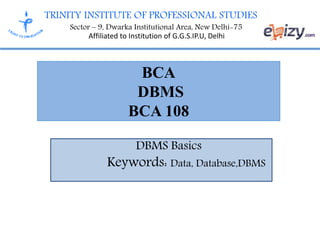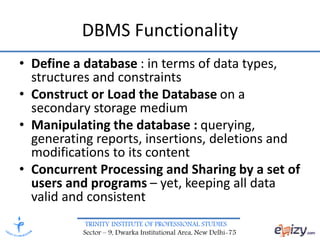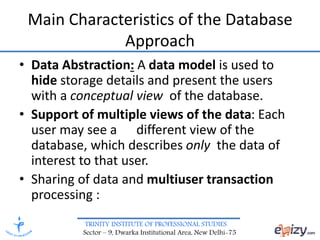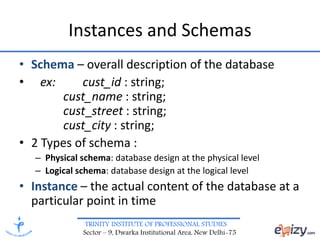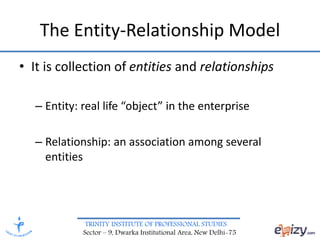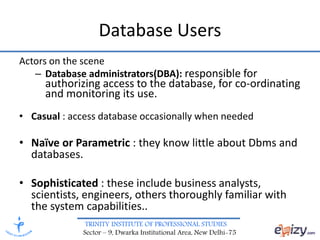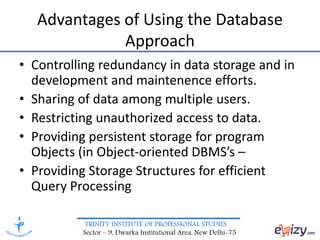Database Management System
- 1. TRINITY INSTITUTE OF PROFESSIONAL STUDIES Sector ¨C 9, Dwarka Institutional Area, New Delhi-75 Affiliated to Institution of G.G.S.IP.U, Delhi BCA DBMS BCA 108 DBMS Basics Keywords: Data, Database,DBMS
- 2. TRINITY INSTITUTE OF PROFESSIONAL STUDIES Sector ¨C 9, Dwarka Institutional Area, New Delhi-75 Database Management System (DBMS) ? Database Management System (DBMS): A software system used to create and maintain database. ? Database System: The DBMS software having data . Sometimes, the applications are also included.
- 3. TRINITY INSTITUTE OF PROFESSIONAL STUDIES Sector ¨C 9, Dwarka Institutional Area, New Delhi-75 DBMS Functionality ? Define a database : in terms of data types, structures and constraints ? Construct or Load the Database on a secondary storage medium ? Manipulating the database : querying, generating reports, insertions, deletions and modifications to its content ? Concurrent Processing and Sharing by a set of users and programs ¨C yet, keeping all data valid and consistent
- 4. TRINITY INSTITUTE OF PROFESSIONAL STUDIES Sector ¨C 9, Dwarka Institutional Area, New Delhi-75 Main Characteristics of the Database Approach ? Self-describing nature of a database system: A DBMS catalog stores the description of the database. The description is called meta-data). This allows the DBMS software to work with different databases. ? Insulation between programs and data: Called program-data independence. Allows changing data storage structures and operations without having to change the DBMS access programs.
- 5. TRINITY INSTITUTE OF PROFESSIONAL STUDIES Sector ¨C 9, Dwarka Institutional Area, New Delhi-75 Main Characteristics of the Database Approach ? Data Abstraction: A data model is used to hide storage details and present the users with a conceptual view of the database. ? Support of multiple views of the data: Each user may see a different view of the database, which describes only the data of interest to that user. ? Sharing of data and multiuser transaction processing :
- 6. TRINITY INSTITUTE OF PROFESSIONAL STUDIES Sector ¨C 9, Dwarka Institutional Area, New Delhi-75 Instances and Schemas ? Schema ¨C overall description of the database ? ex: cust_id : string; cust_name : string; cust_street : string; cust_city : string; ? 2 Types of schema : ¨C Physical schema: database design at the physical level ¨C Logical schema: database design at the logical level ? Instance ¨C the actual content of the database at a particular point in time
- 7. TRINITY INSTITUTE OF PROFESSIONAL STUDIES Sector ¨C 9, Dwarka Institutional Area, New Delhi-75 Data independence ? Physical Data Independence ¨C the ability to modify the physical schema without changing the logical schema ? Logical Data Independence- the ability to modify the logical schema without changing the external view
- 8. TRINITY INSTITUTE OF PROFESSIONAL STUDIES Sector ¨C 9, Dwarka Institutional Area, New Delhi-75 The Entity-Relationship Model ? It is collection of entities and relationships ¨C Entity: real life ¡°object¡± in the enterprise ¨C Relationship: an association among several entities
- 9. TRINITY INSTITUTE OF PROFESSIONAL STUDIES Sector ¨C 9, Dwarka Institutional Area, New Delhi-75 Database Users Actors on the scene ¨C Database administrators(DBA): responsible for authorizing access to the database, for co-ordinating and monitoring its use. ? Casual : access database occasionally when needed ? Na?ve or Parametric : they know little about Dbms and databases. ? Sophisticated : these include business analysts, scientists, engineers, others thoroughly familiar with the system capabilities..
- 10. TRINITY INSTITUTE OF PROFESSIONAL STUDIES Sector ¨C 9, Dwarka Institutional Area, New Delhi-75 Advantages of Using the Database Approach ? Controlling redundancy in data storage and in development and maintenence efforts. ? Sharing of data among multiple users. ? Restricting unauthorized access to data. ? Providing persistent storage for program Objects (in Object-oriented DBMS¡¯s ¨C ? Providing Storage Structures for efficient Query Processing

